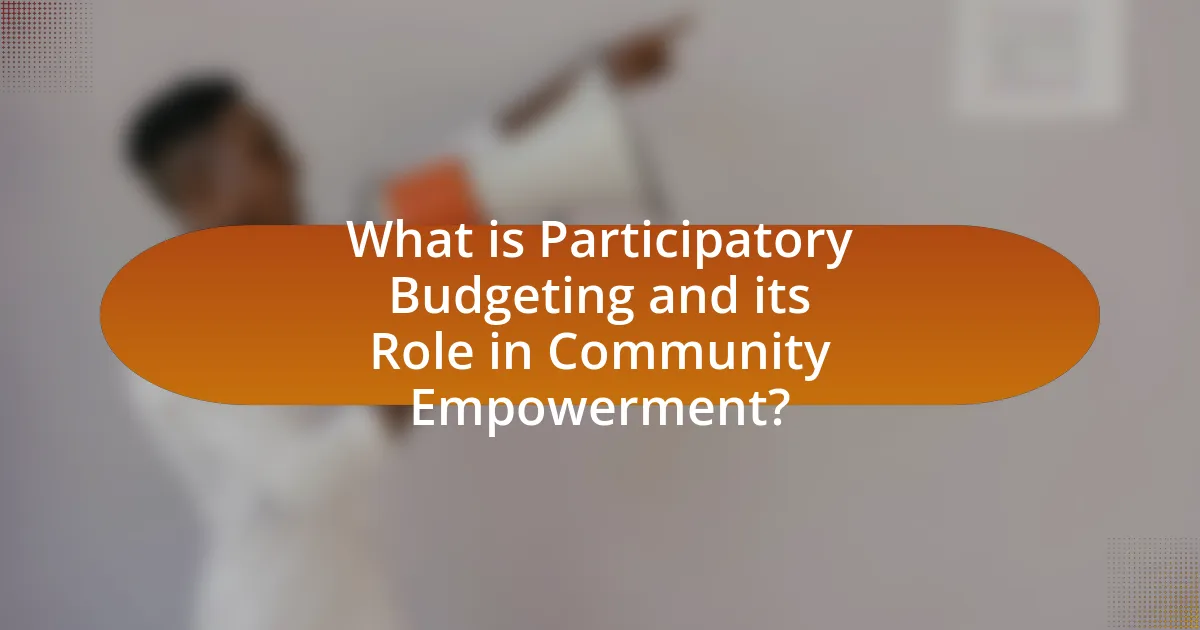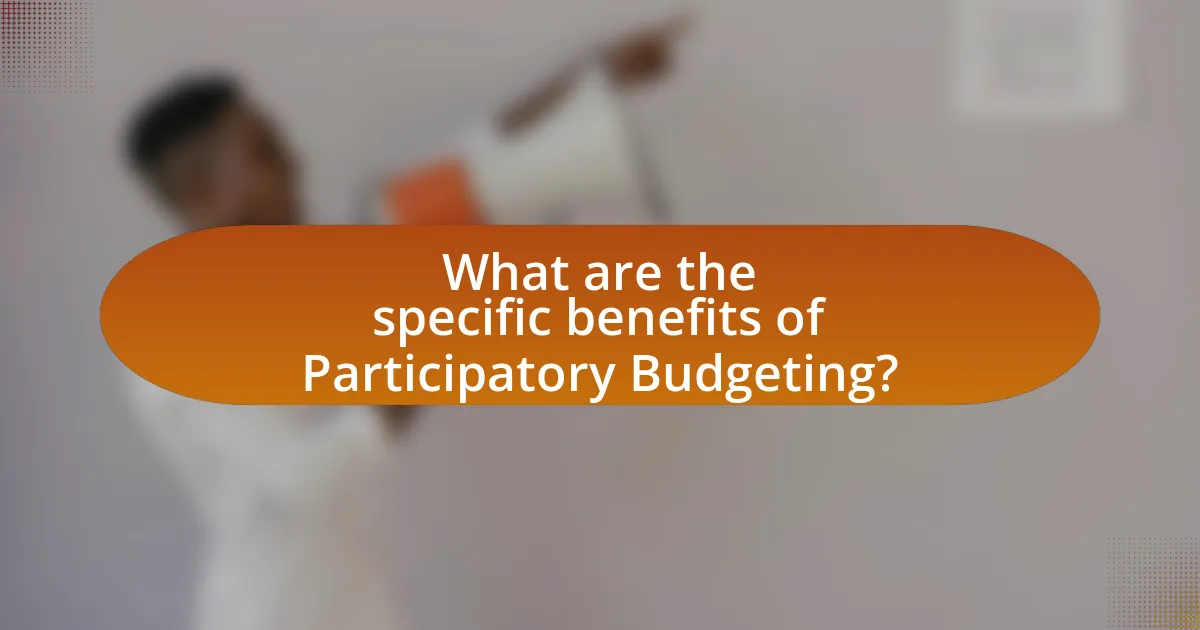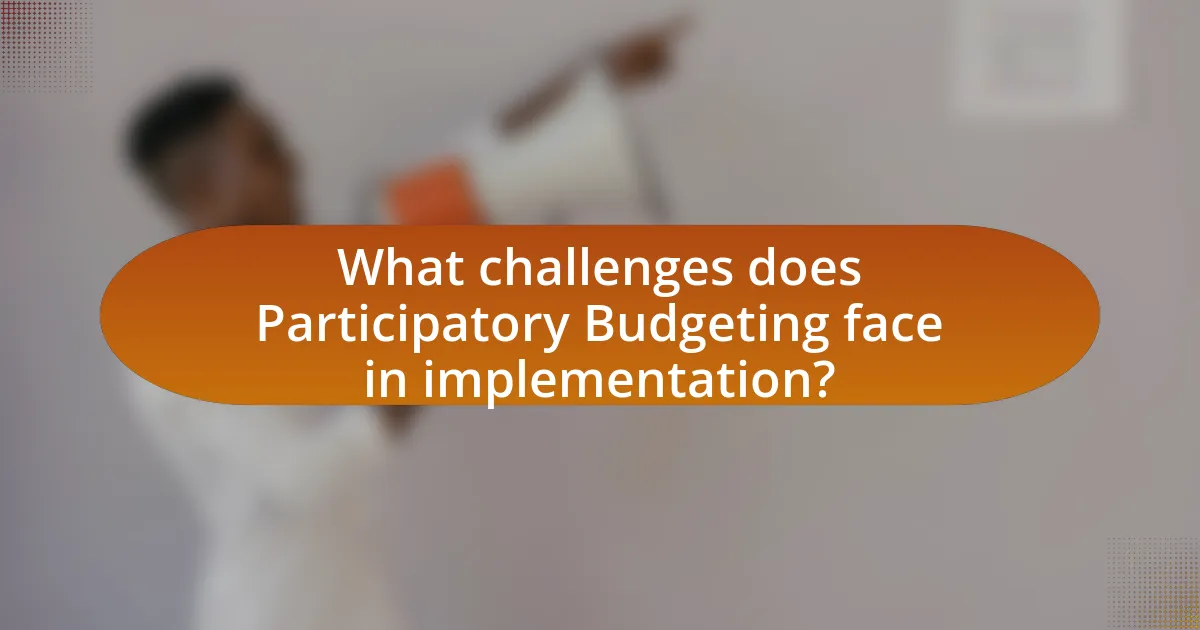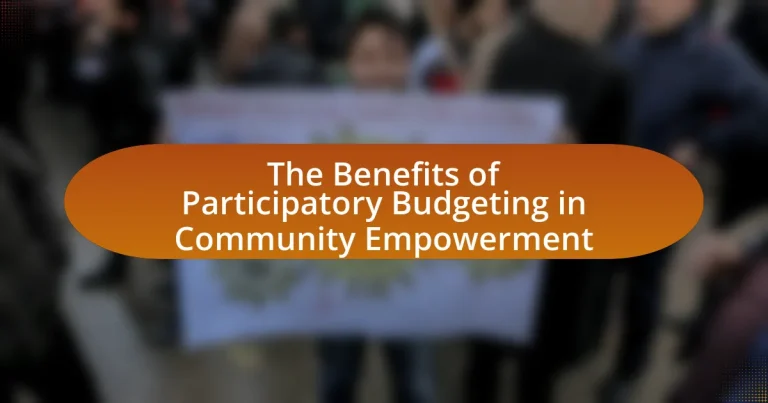Participatory Budgeting (PB) is a democratic process that empowers community members to directly influence the allocation of public funds, enhancing civic engagement and transparency in local governance. This article explores the mechanisms of PB, including project proposal development, community deliberation, and voting, highlighting its role in fostering social equity and addressing the needs of marginalized groups. It also examines the benefits of PB, such as increased public trust, improved local services, and greater accountability in government spending. Additionally, the article discusses the challenges faced in implementing PB and strategies to maximize its effectiveness, including the use of technology and inclusive practices.

What is Participatory Budgeting and its Role in Community Empowerment?
Participatory Budgeting (PB) is a democratic process where community members directly decide how to allocate part of a public budget. This approach empowers communities by giving them a voice in financial decision-making, fostering civic engagement, and enhancing transparency in government spending. Evidence of its effectiveness can be seen in cities like Porto Alegre, Brazil, where PB has led to increased public investment in health and education, demonstrating that when citizens are involved, resources are allocated more effectively to meet community needs.
How does Participatory Budgeting function within communities?
Participatory Budgeting functions within communities by allowing residents to directly influence how public funds are allocated. This process typically involves community meetings where citizens propose and discuss budgetary projects, followed by a voting phase where community members select which projects to fund. Evidence from cities like Porto Alegre, Brazil, shows that Participatory Budgeting can lead to increased civic engagement, improved public services, and greater transparency in government spending, as it empowers residents to have a say in financial decisions that affect their lives.
What are the key processes involved in Participatory Budgeting?
The key processes involved in Participatory Budgeting include project proposal development, community deliberation, voting, and implementation. In project proposal development, community members identify and suggest projects that address local needs. During community deliberation, these proposals are discussed, refined, and prioritized through public meetings and workshops, ensuring diverse input. Voting allows residents to select which projects will receive funding, often through a democratic process that encourages broad participation. Finally, implementation involves executing the chosen projects, with community oversight to ensure accountability and transparency. These processes collectively empower communities by fostering engagement and ensuring that budgetary decisions reflect the priorities of local residents.
How do community members engage in the budgeting process?
Community members engage in the budgeting process through participatory budgeting initiatives, where they actively contribute to decision-making regarding the allocation of public funds. This engagement typically involves attending community meetings, providing input on budget priorities, and voting on proposed projects. Research indicates that participatory budgeting enhances civic engagement and empowers residents by giving them a direct voice in financial decisions that affect their communities, as evidenced by successful implementations in cities like Porto Alegre, Brazil, where community involvement led to increased transparency and accountability in local governance.
Why is Participatory Budgeting important for community empowerment?
Participatory Budgeting is important for community empowerment because it enables residents to have a direct say in how public funds are allocated, fostering a sense of ownership and responsibility. This process encourages civic engagement, as community members actively participate in decision-making, which enhances transparency and accountability in governance. Research shows that cities implementing Participatory Budgeting have seen increased voter turnout and improved public trust in local government, demonstrating its effectiveness in empowering communities. For instance, a study by the Participatory Budgeting Project found that neighborhoods involved in this process reported higher satisfaction with local services and greater community cohesion.
What impact does Participatory Budgeting have on local governance?
Participatory Budgeting enhances local governance by increasing citizen engagement and transparency in budget allocation processes. This approach allows community members to directly influence how public funds are spent, fostering a sense of ownership and accountability. Research indicates that cities implementing Participatory Budgeting, such as Porto Alegre in Brazil, have seen improved public trust and increased civic participation, with over 50% of residents actively involved in budget discussions. This participatory model not only empowers citizens but also leads to more equitable resource distribution, addressing the needs of marginalized communities effectively.
How does it enhance civic engagement among community members?
Participatory budgeting enhances civic engagement among community members by actively involving them in the decision-making process regarding public funds. This approach empowers individuals to voice their needs and priorities, fostering a sense of ownership and responsibility towards community projects. Research indicates that communities implementing participatory budgeting experience increased voter turnout and greater public interest in local governance, as evidenced by a study conducted in Porto Alegre, Brazil, where participatory budgeting led to a 20% increase in civic participation.

What are the specific benefits of Participatory Budgeting?
Participatory Budgeting (PB) enhances community empowerment by fostering greater civic engagement, increasing transparency in government spending, and ensuring that resources are allocated according to the actual needs of the community. Specifically, PB allows residents to directly influence budget decisions, which leads to increased public trust in local government. Research indicates that cities implementing PB have seen higher voter turnout and improved satisfaction with local governance. For instance, a study by the Participatory Budgeting Project found that PB initiatives in New York City resulted in over $30 million allocated to community projects, reflecting the priorities of residents. Additionally, PB promotes social equity by giving marginalized groups a voice in the budgeting process, thereby addressing historical disparities in resource distribution.
How does Participatory Budgeting promote transparency and accountability?
Participatory Budgeting promotes transparency and accountability by actively involving community members in the decision-making process regarding public funds. This engagement allows citizens to directly influence budget allocations, ensuring that their needs and priorities are reflected in government spending. Research indicates that when citizens participate in budgeting, there is a significant increase in public trust and satisfaction with local governance, as evidenced by studies showing that cities implementing Participatory Budgeting report higher levels of citizen engagement and perceived government accountability. For instance, a study by the World Bank found that Participatory Budgeting initiatives in Brazil led to increased transparency in municipal finance and improved public service delivery, demonstrating its effectiveness in fostering an accountable governance framework.
What mechanisms ensure transparency in the budgeting process?
Mechanisms that ensure transparency in the budgeting process include public access to budget documents, stakeholder engagement, and independent audits. Public access allows citizens to review budget proposals and expenditures, fostering accountability. Stakeholder engagement involves community participation in budget discussions, which enhances understanding and trust. Independent audits provide an objective assessment of budget adherence and financial integrity, ensuring that funds are used appropriately. These mechanisms collectively promote transparency, enabling informed public scrutiny and participation in the budgeting process.
How does accountability improve community trust in local government?
Accountability enhances community trust in local government by ensuring transparency and responsiveness in decision-making processes. When local governments are held accountable for their actions, they are more likely to engage with community members, provide clear information about budget allocations, and address public concerns. Research indicates that municipalities that implement participatory budgeting, which involves citizens in financial decision-making, report increased trust levels among residents. For instance, a study by the Participatory Budgeting Project found that cities like Porto Alegre, Brazil, experienced a significant rise in citizen trust and satisfaction due to their transparent budgeting processes. This correlation between accountability and trust is further supported by surveys showing that communities with higher levels of government accountability tend to have more engaged and satisfied citizens.
In what ways does Participatory Budgeting foster social equity?
Participatory Budgeting fosters social equity by actively involving marginalized communities in the decision-making process regarding public funds. This approach ensures that the voices of underrepresented groups are heard, allowing them to prioritize their needs and allocate resources accordingly. For instance, studies have shown that cities implementing Participatory Budgeting, such as Porto Alegre in Brazil, have seen increased investment in low-income neighborhoods, leading to improved access to essential services like education and healthcare. By empowering these communities to influence budgetary decisions, Participatory Budgeting reduces disparities and promotes fair distribution of resources, ultimately enhancing social equity.
How does it address the needs of marginalized groups?
Participatory budgeting addresses the needs of marginalized groups by actively involving them in the decision-making process regarding the allocation of public funds. This inclusion ensures that the voices of underrepresented communities are heard, allowing for the prioritization of their specific needs and concerns. For instance, studies have shown that participatory budgeting initiatives often lead to increased funding for community services such as healthcare, education, and housing, which disproportionately benefit marginalized populations. Additionally, research conducted by the Participatory Budgeting Project indicates that these initiatives can enhance civic engagement and build trust between local governments and communities, further empowering marginalized groups to advocate for their interests.
What role does inclusivity play in the budgeting process?
Inclusivity plays a crucial role in the budgeting process by ensuring that diverse community voices are represented, leading to more equitable resource allocation. When various stakeholders, including marginalized groups, participate in budgeting, it enhances transparency and accountability, fostering trust in the decision-making process. Research indicates that participatory budgeting initiatives, such as those implemented in Porto Alegre, Brazil, have resulted in increased public investment in areas prioritized by the community, demonstrating that inclusive practices can effectively address local needs and improve overall community well-being.

What challenges does Participatory Budgeting face in implementation?
Participatory Budgeting faces several challenges in implementation, including limited public awareness, bureaucratic resistance, and unequal participation. Limited public awareness can hinder community engagement, as many residents may not understand the process or its benefits. Bureaucratic resistance often arises from government officials who may be reluctant to cede control over budget decisions, fearing loss of power or increased workload. Additionally, unequal participation can occur when certain demographics, such as marginalized groups, are underrepresented, leading to skewed priorities that do not reflect the community’s needs. These challenges can significantly impact the effectiveness and equity of Participatory Budgeting initiatives.
What common obstacles hinder effective Participatory Budgeting?
Common obstacles that hinder effective Participatory Budgeting include lack of community engagement, insufficient resources, and inadequate training for participants. Lack of community engagement often results from limited awareness or interest in the budgeting process, which can lead to low participation rates. Insufficient resources, such as funding and staff support, can restrict the ability to implement participatory initiatives effectively. Additionally, inadequate training for participants can create barriers to understanding the budgeting process, limiting their ability to contribute meaningfully. These factors collectively undermine the potential benefits of Participatory Budgeting in fostering community empowerment.
How can communities overcome resistance to Participatory Budgeting?
Communities can overcome resistance to Participatory Budgeting by actively engaging stakeholders through education and transparent communication. By organizing workshops and informational sessions, communities can clarify the process, benefits, and impact of Participatory Budgeting, addressing misconceptions and fears. Research indicates that informed communities are more likely to participate; for instance, a study by the World Bank found that increased awareness led to a 30% rise in participation rates in budgeting processes. Additionally, involving local leaders and influencers can help build trust and encourage broader community involvement, further reducing resistance.
What strategies can be employed to ensure sustained participation?
To ensure sustained participation in participatory budgeting, strategies such as continuous engagement, education, and feedback mechanisms can be employed. Continuous engagement involves regularly involving community members through meetings, workshops, and outreach efforts, which fosters a sense of belonging and commitment. Education about the budgeting process and its impact empowers participants, making them more likely to remain involved. Feedback mechanisms, such as surveys and follow-up discussions, allow participants to voice their opinions and see the results of their contributions, reinforcing their investment in the process. Research indicates that communities with strong engagement strategies see higher levels of participation and satisfaction, as evidenced by the successful implementation of participatory budgeting in cities like Porto Alegre, Brazil, where sustained participation led to improved public services and community trust.
How can communities maximize the benefits of Participatory Budgeting?
Communities can maximize the benefits of Participatory Budgeting by ensuring inclusive participation, transparent processes, and effective communication. Inclusive participation allows diverse community members to contribute their perspectives, which enhances the relevance of budget decisions. For instance, research by the Participatory Budgeting Project indicates that when marginalized groups are actively involved, the outcomes better reflect community needs. Transparent processes build trust and accountability, as seen in successful cases like Porto Alegre, Brazil, where clear guidelines and open discussions led to increased public engagement. Effective communication, including outreach and education about the budgeting process, ensures that all community members understand how to participate and influence decisions, thereby fostering a sense of ownership and empowerment.
What best practices should be followed for successful implementation?
Successful implementation of participatory budgeting requires clear communication, stakeholder engagement, and structured processes. Clear communication ensures that all participants understand the goals and procedures, fostering transparency and trust. Engaging stakeholders, including community members and local organizations, enhances buy-in and diverse input, which is crucial for addressing community needs effectively. Structured processes, such as defined timelines and decision-making criteria, facilitate organization and accountability. Research indicates that communities with strong stakeholder engagement and clear communication strategies report higher satisfaction and better outcomes in participatory budgeting initiatives.
How can technology enhance the Participatory Budgeting experience?
Technology can enhance the Participatory Budgeting experience by facilitating greater engagement and transparency among community members. Digital platforms allow for real-time feedback, enabling participants to propose, discuss, and vote on budget allocations more efficiently. For instance, online voting systems can increase participation rates, as evidenced by a study from the Participatory Budgeting Project, which found that cities using digital tools saw a 30% increase in voter turnout compared to traditional methods. Additionally, data visualization tools can help clarify budget proposals, making it easier for citizens to understand complex financial information and make informed decisions. This integration of technology not only streamlines the process but also fosters a more inclusive environment where diverse voices can be heard and considered.
What are the future prospects of Participatory Budgeting in community empowerment?
The future prospects of Participatory Budgeting (PB) in community empowerment are promising, as it fosters greater civic engagement and enhances transparency in local governance. Research indicates that PB initiatives lead to increased public participation, with studies showing that cities implementing PB have seen participation rates rise by up to 50%. This participatory approach not only empowers communities to influence budgetary decisions but also builds trust between citizens and government entities. Furthermore, as more municipalities adopt PB, the potential for scaling successful models increases, allowing for broader implementation of community-driven projects that address local needs effectively.
How might Participatory Budgeting evolve in response to changing community needs?
Participatory Budgeting (PB) may evolve by incorporating digital platforms to enhance accessibility and engagement, reflecting the increasing reliance on technology in communities. As community needs shift towards more inclusive and immediate feedback mechanisms, PB can integrate online voting and discussion forums, allowing broader participation from diverse demographics, including marginalized groups. For instance, cities like Paris and New York have successfully implemented digital PB processes, resulting in increased voter turnout and more representative project selections. This evolution not only addresses the demand for transparency and efficiency but also aligns with the growing trend of civic tech initiatives aimed at fostering community empowerment.
What innovations could shape the future of Participatory Budgeting?
Innovations that could shape the future of Participatory Budgeting include the integration of digital platforms, data analytics, and blockchain technology. Digital platforms enhance accessibility and engagement by allowing community members to participate in budget discussions and voting online, as evidenced by cities like Paris and New York implementing such systems to increase participation rates. Data analytics can provide insights into community needs and preferences, enabling more informed decision-making, as demonstrated by the use of analytics in cities like Porto Alegre, Brazil, which has seen improved allocation of resources. Blockchain technology can ensure transparency and trust in the budgeting process by securely recording transactions and decisions, which has been explored in pilot projects in various municipalities. These innovations collectively aim to empower communities by making the budgeting process more inclusive, transparent, and efficient.


